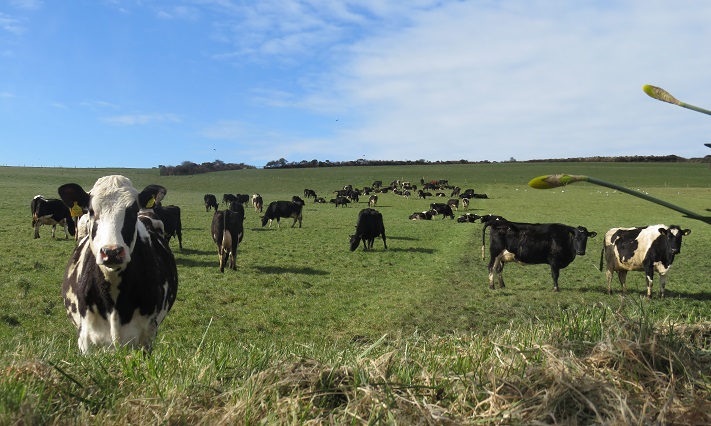Grazing for profit
Rotational grazing at heart of Cornish farm
Chris and Rachel Knowles have been running a spring block calving, grass-based system for 18 years, inspired by a discussion group visit to Ireland in 1999. They now milk 340 cows on 224ha (550 acres) at Trink Farm just outside St Ives in Cornwall.
The crossbred cows weigh between 500kg and 550kg and give an average of 5,500 litres of milk at 4.6% butterfat and 3.6% protein. Eighty per cent (4,400 litres) of the milk comes from forage and 800kg of cake is fed per lactation. Most of the milk is sold to Arla on a manufacturing contract, with a small amount now being sold direct to customers.
Fresh milk is passed through an in-line pasteuriser and ready for sale by 10am the same day it came from the cow. Milk is delivered to local cafés, shops and children’s nurseries and customers come to the farm to collect from a vending machine in the dairy. Rotational grazing is at the heart of Trink Farm, with grass growth measured weekly during the growing season and the AgriNet computer software working out a feed wedge – or conveyor belt of grass that will become available over the coming days.
 Fresh calvers out grazing Megabite in February
Fresh calvers out grazing Megabite in February
“So many farmers spend hours working out exactly how much cake or silage the cows will eat, but they don’t do the same thing for when they are grazing,” says Chris.
Turnout at Trink Farm is in mid February for at least a few hours a day once the cows start to calve. Two hundred cows calve in the first three weeks.
“The first round of grazing is easy because there are no dung pats or rejection sites to mess things up,” explains Chris. “We have learned how to get the cows to clear the fields to encourage high quality regrowth.
“2017 was a phenomenal year for grass growth – we grew an average of 14 tonnes Dry Matter/ha and utilised at least 80% of this. We cut 46 acres for silage bales on 6 April and had never done that before.
“The cows are turned out onto a fresh allocation of grass every 12 hours – accessed by astro-turfed tracks and with an electric fence moved every day, which takes me 15 minutes.
“I try and encourage a ‘mange-tout’ system. If I gave them enough space for 36 hours they would eat and then lie down on the flatter bits of the field. If I only give them enough for 12 hours they eat it all!”
There are nine rounds of grazing – with each one lasting 20 to 25 days. Silage is only taken from the 115ha (281 acres) grazing platform when grass growth is high, and round bales are taken whenever there is more growth in fields than is needed to graze.
Chris also pre-mows the fields on the fourth round (20 May to 20 June), through the grass heading period to maintain grass feed quality for the rest of the year.
Sixteen hectares (39 acres) of grass are reseeded every year – half on the grazing platform and half on the silage and youngstock ground. The mixture sown across the farm is Megabite – an intermediate and late heading perennial ryegrass, timothy and white clover mix from Oliver Seeds. The ryegrasses are diploids with top disease ratings and the clover adds palatability and high intake potential, as well as adding nitrogen to the soil.
Reseeding on the grazing platform takes place after the second grazing, when any remaining grass is killed with non-selective herbicide before the seed is direct drilled. This area will come back into the grazing round during July.
Chris applies 150kg N/ha (120 units/acre) of Humber Palmers fertiliser a year with added sulphur and sodium.
Three cuts of high quality silage are taken by contractors each season. The cows are housed from the beginning of December as soil conditions do not allow out-wintering of adult stock. Youngstock is out-wintered and fed round bales of grass silage.
“We are proud to tell our customers that grass is food – and the cows are just here to convert that into food that we can eat,” says Chris. “It is also low cost, making us better able to survive the lows of the milk price cycle, which is worth a great deal.”
This article first appeared in the March 2018 issue of British Dairying magazine
